MoleculeValuePlot3D[mol,"prop"]
returns a three-dimensional plot of the molecule mol with colors corresponding to the atom or bond property "prop".
MoleculeValuePlot3D[mol,{item1val1,…}]
returns a plot with atoms or bonds colored according to the specified values.
MoleculeValuePlot3D[mol,func]
uses the pure function func to determine values by which to color atoms or bonds.


MoleculeValuePlot3D
MoleculeValuePlot3D[mol,"prop"]
returns a three-dimensional plot of the molecule mol with colors corresponding to the atom or bond property "prop".
MoleculeValuePlot3D[mol,{item1val1,…}]
returns a plot with atoms or bonds colored according to the specified values.
MoleculeValuePlot3D[mol,func]
uses the pure function func to determine values by which to color atoms or bonds.
Details

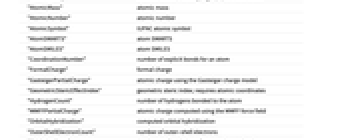
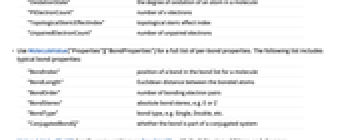
- Get a 3D molecule plot with atoms or bonds colored according to property values.
- MoleculeValuePlot3D uses color to associate numeric or categorical values with regions in a molecule.
- mol can be a Molecule object or something that can be easily converted to one, such as a systematic chemical name, a "Chemical" entity, a BioSequence or an ExternalIdentifier.
- "prop" should be a Molecule property that returns values for atoms or bonds.
- func should be a pure function using named slots, e.g. (#AtomicNumber/#FormalCharge&).
- EntityProperty["Element",…] can be used to plot the property values for the types of elements in the molecule.
- Use MoleculeValue["Properties"]["AtomProperties"] for a full list of per-atom properties. The following list includes typical atom properties:
-
"AromaticAtomQ" whether the atom is aromatic "AtomChirality" absolute atomic chirality, e.g. R, S, for chiral atoms "AtomicMass" atomic mass "AtomicNumber" atomic number "AtomicSymbol" IUPAC atomic symbol "AtomSMARTS" atom SMARTS "AtomSMILES" atom SMILES "CoordinationNumber" number of explicit bonds for an atom "FormalCharge" formal charge "GasteigerPartialCharge" atomic charge using the Gasteiger charge model "GeometricStericEffectIndex" geometric steric index; requires atomic coordinates "HydrogenCount" number of hydrogens bonded to the atom "MMFFPartialCharge" atomic charge computed using the MMFF force field "OrbitalHybridization" computed orbital hybridization "OuterShellElectronCount" number of outer-shell electrons "OxidationState" the degree of oxidation of an atom in a molecule "PiElectronCount" number of  electrons
electrons"TopologicalStericEffectIndex" topological steric effect index "UnpairedElectronCount" number of unpaired electrons - Use MoleculeValue["Properties"]["BondProperties"] for a full list of per-bond properties. The following list includes typical bond properties:
-
"BondIndex" position of a bond in the bond list for a molecule "BondLength" Euclidean distance between the bonded atoms "BondOrder" number of bonding electron pairs "BondStereo" absolute bond stereo, e.g. E or Z "BondType" bond type, e.g. Single, Double, etc. "ConjugatedBondQ" whether the bond is part of a conjugated system - MoleculeValuePlot3D has the same options as Graphics3D, with the following additions and changes: [List of all options]
-
ColorFunction Automatic how to deteremine coloring ColorFunctionScaling True whether to scale arguments to ColorFunction ColorRules Automatic colors to use for specific values when plotting categorical data IncludeHydrogens Automatic whether to show hydrogen atoms Method Automatic can be "Numerical" or "Categorical" PlotLegends Automatic legends for highlights PlotTheme $PlotTheme overall theme for the plot -
AlignmentPoint Center the default point in the graphic to align with AspectRatio Automatic ratio of height to width Axes False whether to draw axes AxesEdge Automatic on which edges to put axes AxesLabel None axes labels AxesOrigin Automatic where axes should cross AxesStyle {} graphics directives to specify the style for axes Background None background color for the plot BaselinePosition Automatic how to align with a surrounding text baseline BaseStyle {} base style specifications for the graphic Boxed True whether to draw the bounding box BoxRatios Automatic bounding 3D box ratios BoxStyle {} style specifications for the box ClipPlanes None clipping planes ClipPlanesStyle Automatic style specifications for clipping planes ColorFunction Automatic how to deteremine coloring ColorFunctionScaling True whether to scale arguments to ColorFunction ColorRules Automatic colors to use for specific values when plotting categorical data ContentSelectable Automatic whether to allow contents to be selected ControllerLinking False when to link to external rotation controllers ControllerPath Automatic what external controllers to try to use Epilog {} 2D graphics primitives to be rendered after the main plot FaceGrids None grid lines to draw on the bounding box FaceGridsStyle {} style specifications for face grids FormatType TraditionalForm default format type for text ImageMargins 0. the margins to leave around the graphic ImagePadding All what extra padding to allow for labels, etc. ImageSize Automatic absolute size at which to render the graphic IncludeHydrogens Automatic whether to show hydrogen atoms LabelStyle {} style specifications for labels Lighting Automatic simulated light sources to use Method Automatic can be "Numerical" or "Categorical" PlotLabel None a label for the plot PlotLegends Automatic legends for highlights PlotRange All range of values to include PlotRangePadding Automatic how much to pad the range of values PlotRegion Automatic final display region to be filled PlotTheme $PlotTheme overall theme for the plot PreserveImageOptions Automatic whether to preserve image options when displaying new versions of the same graphic Prolog {} 2D graphics primitives to be rendered before the main plot RotationAction "Fit" how to render after interactive rotation SphericalRegion Automatic whether to make the circumscribing sphere fit in the final display area Ticks Automatic specification for ticks TicksStyle {} style specification for ticks TouchscreenAutoZoom False whether to zoom to fullscreen when activated on a touchscreen ViewAngle Automatic angle of the field of view ViewCenter Automatic point to display at the center ViewMatrix Automatic explicit transformation matrix ViewPoint {1.3,-2.4,2.} viewing position ViewProjection Automatic projection method for rendering objects distant from the viewer ViewRange All range of viewing distances to include ViewVector Automatic position and direction of a simulated camera ViewVertical {0,0,1} direction to make vertical
List of all options
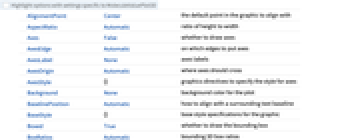
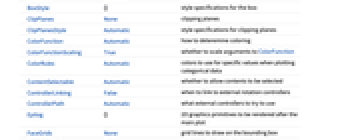
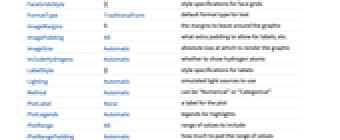
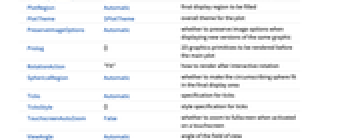
Examples
open all close allBasic Examples (4)
Scope (2)
Options (4)
Method (1)
By default, numeric data is plotted using a continuous color function:
Use Method"Categorical" to force a different legend type:
PlotLegends (1)
Plot legends are shown by default for most inputs:
Use PlotLegendsNone to disable automatic legends:
Specify a specific legend placement and options for the legend:
See Also
History
Text
Wolfram Research (2025), MoleculeValuePlot3D, Wolfram Language function, https://reference.wolfram.com/language/ref/MoleculeValuePlot3D.html.
CMS
Wolfram Language. 2025. "MoleculeValuePlot3D." Wolfram Language & System Documentation Center. Wolfram Research. https://reference.wolfram.com/language/ref/MoleculeValuePlot3D.html.
APA
Wolfram Language. (2025). MoleculeValuePlot3D. Wolfram Language & System Documentation Center. Retrieved from https://reference.wolfram.com/language/ref/MoleculeValuePlot3D.html
BibTeX
@misc{reference.wolfram_2025_moleculevalueplot3d, author="Wolfram Research", title="{MoleculeValuePlot3D}", year="2025", howpublished="\url{https://reference.wolfram.com/language/ref/MoleculeValuePlot3D.html}", note=[Accessed: 27-December-2025]}
BibLaTeX
@online{reference.wolfram_2025_moleculevalueplot3d, organization={Wolfram Research}, title={MoleculeValuePlot3D}, year={2025}, url={https://reference.wolfram.com/language/ref/MoleculeValuePlot3D.html}, note=[Accessed: 27-December-2025]}